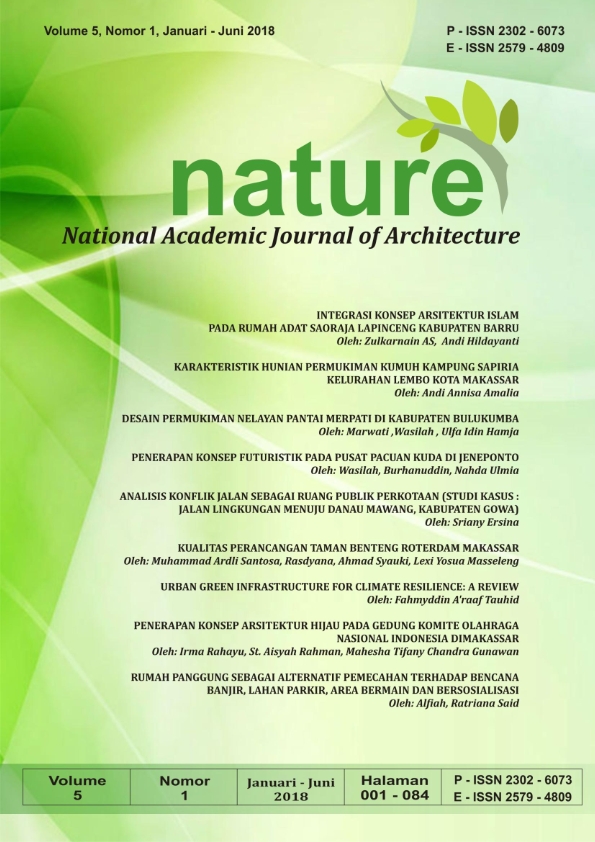URBAN GREEN INFRASTRUCTURE FOR CLIMATE RESILIENCE: A REVIEW
Abstract
Abstract: As the climate change affectingon coastal cities by increasing the intensity and frequency of climate related disasters such as flooding, sea level rise, drought etc., the need to explore other urban infrastructure strategies than conventional one is required. This alternative not only mitigate the impacts but also improve the urban climate resilience. In line with it, green infrastructure/GI can be sustainable alternative in that way combine with gray infrastructure. Therefore, this paper reviews the concept of GI to advance the urban resilience associated with climate related disasters. Some strategies based on the current literature and projects are also recommended including managing flood risk, building resiliency to drought, reducing the urban heat island effect, lowering building energy demands, improving coastal resiliency, and reducing energy needed to manage water.
Key words: Green Infrastructure, Climate Resilience, Urban Resilience, Sustainability, Flood, Drought,Sea level Rise.
Downloads
References
Akbari, H., Pomerantz, M., & Taha, H. (2001). Cool Surfaces and Shade Trees to Reduce Energy Use and Improve Air Quality in Urban Areas. Solar Energy, 70, 3, 295-310.
Barbier, E. B., Georgiou, I. Y., Enchelmeyer, B., & Reed, D. J. (2013). The Value of Wetlands in Protecting Southeast Louisiana from Hurricane Storm Surges. PLoS ONE,8(3). doi:10.1371/journal.pone.0058715.
Emmanuel, O., Cassidy, J., & Donald, B. (2017). The data gap: An analysis of data availability on disaster losses in sub-Saharan African cities. International Journal of Disaster Risk Reduction.26,24-33, https://doi.org/10.1016/j.ijdrr.2017.09.026.
Fahim, N., David, W., Danielle, C., & David, R. (2018). An investigation of coastal climate change risk assessment practice in Australia. Environmental Science & Policy. 80,9-20. https://doi.org/10.1016/j.envsci.2017.11.003.
Firas, S., & Michael, P. (2016). The role of nature-based infrastructure (NBI) in coastal resiliency planning: A literature review. Journal of Environmental Management.183,1088-1098. https://doi.org/10.1016/j.jenvman.2016.09.077.
Gill, S. E., Handley, J. F., Ennos, A. R., &Pauleit, S. (2007). Adapting cities for climate change: The role of the green infrastructure. Built Environment, 33(1), 115-133. DOI: 10.2148/benv.33.1.115
IPCC (2012). Managing the Risks of Extreme Events and Disasters to Advance Climate Change Adaptation. Cambridge University Press. Cambridge, 1-502.
IPCC (2014). AR5 – Climate Change 2014 – Impacts, Adaptation and Vulnerability. Cambridge University Press. Cambridge. 59-60.
Klok, L., &Kluck, J. (2018). Reasons to adapt to urban heat (in the Netherlands). Urban Climate, 23, 342-351. https://doi.org/10.1016/j.uclim.2016.10.005.
Liu, K. & Baskaran, B. (2003). Thermal Performance of Green Roofs through Field Evaluation. Greening Rooftops for Sustainable Communities, Chicago.
Matthews, T., Lo, A, & Byrne, J.A. (2015). Reconceptualizing green infrastructure for climate change adaptation: Barriers to adoption and drivers for uptake by spatial planners. Landsc. Urban Plan. 138, 155-163.
Manyena, S.B. (2006). Rural local authorities and disaster resilience in Zimbabwe. Disaster Preventionand Management, 15, 810–820.
Mark, A., Edward, T., McMahon, Mark, A.(2006).Green Infrastructure: Linking Landscapes and Communities. The Conservation Fund.
Mentens, J., Raes, D., Hermy, M. (2006). Green roofs as a tool for solving the rainwater runoff problem in the urbanized 21st century?.Landscape and urban planning 77 (3), 217-226.
NYC Enviromentl Protection (2018). Rain Barrel Giveaway Program. Available at http://www.nyc.gov/html/dep/html/stormwater/rainbarrel.shtml.
Pelling M (2003) The vulnerability of cities: Natural disasters and social resilience. (London: Earthscan).
Pielke, R. A. (2013). Climate vulnerability: Understanding and addressing threats to essential resources. Amsterdam: Academic Press is an imprint of Elsevier.
Rajashree, K., Aparna, R., Anurag, B.(2018). Urban Heat Island studies in South Asia: A critical review. Urban Climate. https://doi.org/10.1016/j.uclim.2017.12.006.
Rock, B. N., Lynne, C., Walker, H., Bradbury, J., Dingman, S. L., & Federer, C. A. (2001). Climate impacts on regional water. The New England regional assessment. University of New Hampshire.
Trenberth, K. (2011). Changes in precipitation with climate change. Climate Research, 47(1/2), 123-138. http://www.jstor.org/stable/24872346.
UNISDR (2005b). Hyogo Framework for Action 2005-2015: Building the Resilience of Nations and Communities to Disasters. World Conference on Disaster Reduction. 18-22 January 2005, Kobe, Hyogo, Japan. A/CONF.206/6. UNISDR.
UNISDR (2009). Terminology on Disaster Risk Reduction. UNISDR.
US Environmental Protection Agency/ USEPA. (2010). Green infrastructure case studies: Municipal policies for managing stormwater with green infrastructure (EPA-841-F-10e004). Washington, DC: Office of Wetlands, Oceans and Watersheds.
Yosef, J. (2013). Planning the resilient city: concepts and strategies for coping with climate change and environmental risk. Cities, 31,220-229. HTTPS://DOI.ORG/10.1016/J.CITIES.2012.05.004.
Copyright (c) 2018 Fahmyddin Araaf Tauhid

This work is licensed under a Creative Commons Attribution-ShareAlike 4.0 International License.
By submitting your manuscript to our journal, you are following Copyright and License











